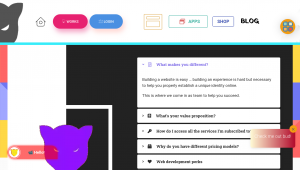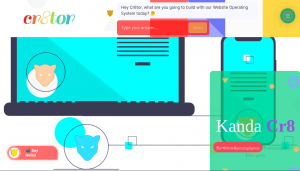Web development is the process of building websites and applications for the Internet (World Wide Web) or an Intranet (a closed network in a company, for example) and it involves writing code to be stored in databases to display select views in browsers after being returned by a server on client request.
Web Development can be categorized into client-side, server-side, and database technologies. In the development community, we colloquially refer to development for these categories as front-end, back-end, and full-stack development respectively. To explain them in the simplest of terms, development for the Client-side involves coding for everything that the end-user (browser/client) sees. For example, page layouts, font faces and styles, images, colours, contact and registration forms, navigation menus, animation and scrolling effects, etc. Development for the Server-side involves coding for everything that happens in the background when the client interacts with a website or web application. For example, filling and submitting registration or contact forms. Posting questions and comments in forums. Making online purchases. Database development involves designing and managing the data stores that hold all the code created during both the front-end and back-end development processes as well as fashioning the best ways for handling their storage and server-related tasks given in different conditions.
To understand how these fit together, let’s take a step back for a quick refresher on how interneting works.
When you enter a link in your browser’s URL field, the browser sends a request for the corresponding webpage through your ISP which directs that request to the appropriate server where the data you need is stored in databases and parsed into styled web pages, tables, dynamic access points, etc. Your ISP knows where to forward your request to the same way the concerned server knows where to send its response and that’s with thanks to the DNS and other technologies working together, but let’s skip those for now. What is important to remember is that you, through your browser (client), request to load certain webpages to read the news, check game scores, shop at different stores, etc. and within seconds, you have nicely styled websites waiting for navigation at your convenience.
At Wpwakanda, we make use of the most reliable technologies to ensure that the software we build does not just employ the latest trends and security practices, but that they can fulfil the purpose for which they are created and keep both our clients and their clients satisfied.
Cornerstones
HyperText Markup Language (HTML) forms the fundamental building block of every web page. With it, we ‘mark up’ raw content using the HTML tags which tell your web browser how different parts of the content in a web page should be displayed. We believe that creating an HTML document with proper markup is the first step to coding any web page and that is why we use the latest major version, HTML 5, to take advantage of its futuristic properties and built-in security enhancements.
Cascading Style Sheets (CSS) is the styling language used to code for the appearance of web pages. With it, we tell web browsers how the HTML elements in a web page should be displayed i.e. their colour, transition effects, animation effects, transparency, etc. CSS styles can be added to texts, images, pseudo-elements, and embedded content. Virtually anything on a web page can be styled using CSS and with the latest version, CSS 3, our front-end developers add colourful flesh to the mockups created by our Design Team for the perfect look and feel. There are several coding techniques, style conventions, frameworks and tools that we use such as CSS grids, Flexbox, Bootstrap, and SASS.
PHP Hypertext Preprocessor (PHP) is a fast, flexible, and pragmatic general-purpose scripting language designed for server-side operations. It is designed to handle communications between web browsers and the technologies running in the backend, especially databases. This is combined with a solid support community and tons of practical uses in different kinds of projects and comprehensive documentation that guides developers along. Among the PHP frameworks that we use is Laravel, a free and open-source web framework for developing applications after the Symfony-based model–view–controller architectural pattern. If you think of any modern web application, chances are that it was built with PHP.
JavaScript (JS) is a high-level language, multi-paradigm, and often a just-in-time compiled programming language that allows developers to perform all sorts of operations on the client-side (browser). This includes creating advanced animations, dynamically creating HTML content, performing mathematical operations in real-time, and dynamically editing the UI/UX of web pages. JS is the backbone of several web frameworks with notable mentions like jQuery, an open-source library designed to simplify HTML DOM tree traversal and manipulation, Ajax, CSS animations, and event handling; and React, an open-source library that was built by Facebook and maintained alongside volunteer developers and companies for building user interfaces. My favourite JavaScript line is Atwood’s Law which states that “Any application that can be written in JavaScript, will eventually be written in JavaScript”.
Structured Query Language (SQL) is a domain-specific language designed for communicating with databases. It has long become the standard language for managing relational databases and is behind the functional data storage and maintenance of many corporations. Just like the best of these corporations, we combine SQL and its assortment of tools to manage data conveniently and reliably – not forgetting to put several security measures to avoid data loss or leakage.
WordPress for Ecommerce
The digital market is among the highest-grossing businesses today as eCommerce websites make up to 12% of the Internet running on different platforms. After taking our time to review all the recommended platforms, we chose to work with WordPress and have never had a reason to regret our choice.
WordPress (WP) is a free and open-source content management system that was first launched in 2003. Since then, it has grown to be the world’s most popular CMS powering an unparalleled 37.6% of all websites on the Internet, 60.8% of the CMS market, and 22% of the world’s top 1 million eCommerce sites. Written in PHP and typically paired with MariaDB or MySQL, WordPress features an extensive plugin architecture and template system which allows us to build projects rapidly in a structured, replicable manner. Its 55,000+ plugins and 100,000+ themes enable our developers to create websites that look and feel unique irrespective of the underlying technologies. The fact that it is open-source gives us the peculiar ability to customize our web projects as much as we want them as well as the possibility to integrate with other software, especially our in-house products.
At Wpwakanda, we build eCommerce websites that allow businesses to showcase and sell their products and services online. Our websites utilise the best practices to give potential customers, prospects, and business partners access to information about the businesses, services, and their products. Whether your project is Business-to-Business (B2B), Business-to-Consumer (B2C), Consumer-to-Business (C2B), Business-to-Administration (B2A), or Consumer-to-Administration (C2A), our team of managers, designers & developers, data and risk management analysts, work dedicatedly to provide you with the best services.
Together, these technologies sit as cornerstones that enable us to build unique landing pages, blogs, forums, portfolios, online stores, advanced eCommerce platforms, polling & betting sites, and web applications.
Development Classes
Rapid Development
Rapid Development is the project tier in which we use a curated list of industry tools and software to build websites and eCommerce storefronts in relatively short periods. When building WordPress websites, we use any of our affiliated themes and plugins which we know to be reliable and reusable for chosen designs and content management tasks and then combine them to breathe life into projects.
Bespoke Development
Bespoke development is the tier in which projects are built completely from scratch. No templates and no plugins – just all in-house products, For example, bespoke WordPress websites for eCommerce are developed using custom-built themes designed for the specific business and typically offer only the workflow options chosen by the client. Bespoke projects take a longer time to complete as they require a lot more planning, testing, maintenance, and resources. Although there are cases in which we use technologies not among our goto development toolkit for rapid development, Bespoke projects allow our clients to pick and choose the specifics of the product they want us to build for them.
At Wpwakanda, our web projects are fully mobile responsive, highly search engine optimized, and expertly designed to be modern, attractive, and easy to use. Our project managers work collaboratively with our clients to make sure that the project’s key objectives align with their business even as we strive to deliver meaningful results and ultimately positive returns on the digital investment.






